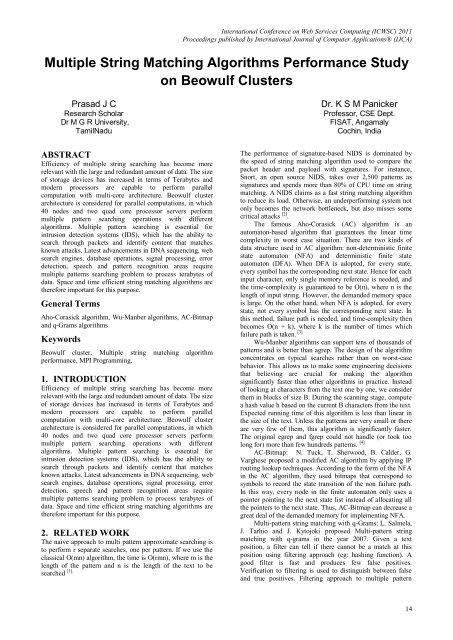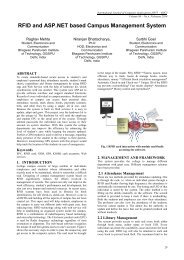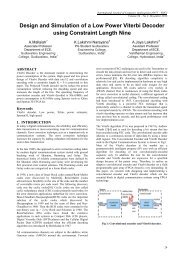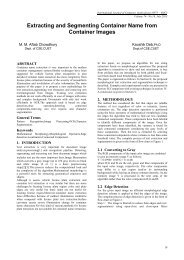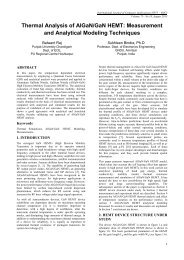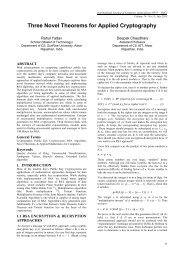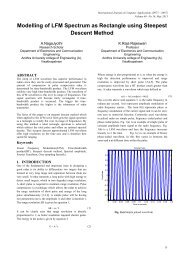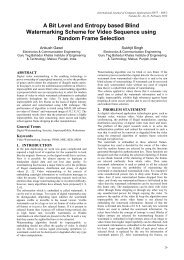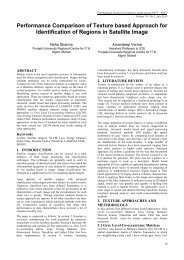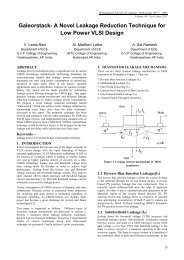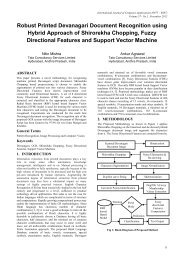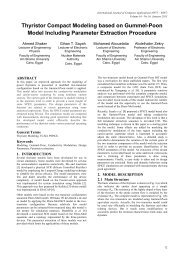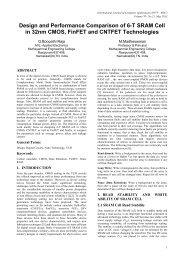IJCA Word Template - International Journal of Computer ...
IJCA Word Template - International Journal of Computer ...
IJCA Word Template - International Journal of Computer ...
Create successful ePaper yourself
Turn your PDF publications into a flip-book with our unique Google optimized e-Paper software.
<strong>International</strong> Conference on Web Services Computing (ICWSC) 2011<br />
Proceedings published by <strong>International</strong> <strong>Journal</strong> <strong>of</strong> <strong>Computer</strong> Applications® (<strong>IJCA</strong>)<br />
Multiple String Matching Algorithms Performance Study<br />
on Beowulf Clusters<br />
Prasad J C<br />
Research Scholar<br />
Dr M G R University,<br />
TamilNadu<br />
ABSTRACT<br />
Efficiency <strong>of</strong> multiple string searching has become more<br />
relevant with the large and redundant amount <strong>of</strong> data. The size<br />
<strong>of</strong> storage devices has increased in terms <strong>of</strong> Terabytes and<br />
modern processors are capable to perform parallel<br />
computation with multi-core architecture. Beowulf cluster<br />
architecture is considered for parallel computations, in which<br />
40 nodes and two quad core processor servers perform<br />
multiple pattern searching operations with different<br />
algorithms. Multiple pattern searching is essential for<br />
intrusion detection systems (IDS), which has the ability to<br />
search through packets and identify content that matches<br />
known attacks. Latest advancements in DNA sequencing, web<br />
search engines, database operations, signal processing, error<br />
detection, speech and pattern recognition areas require<br />
multiple patterns searching problem to process terabytes <strong>of</strong><br />
data. Space and time efficient string matching algorithms are<br />
therefore important for this purpose.<br />
General Terms<br />
Aho-Corasick algorithm, Wu-Manber algorithms, AC-Bitmap<br />
and q-Grams algorithms<br />
Keywords<br />
Beowulf cluster, Multiple string matching algorithm<br />
performance, MPI Programming.<br />
1. INTRODUCTION<br />
Efficiency <strong>of</strong> multiple string searching has become more<br />
relevant with the large and redundant amount <strong>of</strong> data. The size<br />
<strong>of</strong> storage devices has increased in terms <strong>of</strong> Terabytes and<br />
modern processors are capable to perform parallel<br />
computation with multi-core architecture. Beowulf cluster<br />
architecture is considered for parallel computations, in which<br />
40 nodes and two quad core processor servers perform<br />
multiple pattern searching operations with different<br />
algorithms. Multiple pattern searching is essential for<br />
intrusion detection systems (IDS), which has the ability to<br />
search through packets and identify content that matches<br />
known attacks. Latest advancements in DNA sequencing, web<br />
search engines, database operations, signal processing, error<br />
detection, speech and pattern recognition areas require<br />
multiple patterns searching problem to process terabytes <strong>of</strong><br />
data. Space and time efficient string matching algorithms are<br />
therefore important for this purpose.<br />
2. RELATED WORK<br />
The naive approach to multi pattern approximate searching is<br />
to perform r separate searches, one per pattern. If we use the<br />
classical O(mn) algorithm, the time is O(rmn), where m is the<br />
length <strong>of</strong> the pattern and n is the length <strong>of</strong> the text to be<br />
searched [1].<br />
Dr. K S M Panicker<br />
Pr<strong>of</strong>essor, CSE Dept.<br />
FISAT, Angamaly<br />
Cochin, India<br />
The performance <strong>of</strong> signature-based NIDS is dominated by<br />
the speed <strong>of</strong> string matching algorithm used to compare the<br />
packet header and payload with signatures. For instance,<br />
Snort, an open source NIDS, takes over 2,500 patterns as<br />
signatures and spends more than 80% <strong>of</strong> CPU time on string<br />
matching. A NIDS claims as a fast string matching algorithm<br />
to reduce its load. Otherwise, an underperforming system not<br />
only becomes the network bottleneck, but also misses some<br />
critical attacks [2] .<br />
The famous Aho-Corasick (AC) algorithm is an<br />
automaton-based algorithm that guarantees the linear time<br />
complexity in worst case situation. There are two kinds <strong>of</strong><br />
data structure used in AC algorithm: non-deterministic finite<br />
state automaton (NFA) and deterministic finite state<br />
automaton (DFA). When DFA is adopted, for every state,<br />
every symbol has the corresponding next state. Hence for each<br />
input character, only single memory reference is needed, and<br />
the time-complexity is guaranteed to be O(n), where n is the<br />
length <strong>of</strong> input string. However, the demanded memory space<br />
is large. On the other hand, when NFA is adopted, for every<br />
state, not every symbol has the corresponding next state. In<br />
this method, failure path is needed, and time-complexity then<br />
becomes O(n + k), where k is the number <strong>of</strong> times which<br />
failure path is taken. [3]<br />
Wu-Manber algorithms can support tens <strong>of</strong> thousands <strong>of</strong><br />
patterns and is better than agrep. The design <strong>of</strong> the algorithm<br />
concentrates on typical searches rather than on worst-case<br />
behavior. This allows us to make some engineering decisions<br />
that believing are crucial for making the algorithm<br />
significantly faster than other algorithms in practice. Instead<br />
<strong>of</strong> looking at characters from the text one by one, we consider<br />
them in blocks <strong>of</strong> size B. During the scanning stage, compute<br />
a hash value h based on the current B characters from the text.<br />
Expected running time <strong>of</strong> this algorithm is less than linear in<br />
the size <strong>of</strong> the text. Unless the patterns are very small or there<br />
are very few <strong>of</strong> them, this algorithm is significantly faster.<br />
The original egrep and fgrep could not handle (or took too<br />
long for) more than few hundreds patterns. [4]<br />
AC-Bitmap: N. Tuck, T. Sherwood, B. Calder, G.<br />
Varghese proposed a modified AC algorithm by applying IP<br />
routing lookup techniques. According to the form <strong>of</strong> the NFA<br />
in the AC algorithm, they used bitmaps that correspond to<br />
symbols to record the state transition <strong>of</strong> the non failure path.<br />
In this way, every node in the finite automaton only uses a<br />
pointer pointing to the next state list instead <strong>of</strong> allocating all<br />
the pointers to the next state. Thus, AC-Bitmap can decrease a<br />
great deal <strong>of</strong> the demanded memory for implementing NFA.<br />
Multi-pattern string matching with q-Grams: L. Salmela,<br />
J. Tarhio and J. Kytojoki proposed Multi-pattern string<br />
matching with q-grams in the year 2007. Given a text<br />
position, a filter can tell if there cannot be a match at this<br />
position using filtering approach (eg: hashing function). A<br />
good filter is fast and produces few false positives.<br />
Verification to filtering is used to distinguish between false<br />
and true positives. Filtering approach to multiple pattern<br />
14
matching transform patterns to sequences <strong>of</strong> q-grams and<br />
filter with a character class pattern built from the transformed<br />
pattern set. Then it verify with a Rabin-Karp style<br />
algorithm. [6] q-Grams filters have three‚ recognition zones`<br />
depending on the number <strong>of</strong> errors : Guarantee zone (finds all<br />
approximate matches), Heuristic zone (finds some <strong>of</strong> the<br />
approximate matches) and Negative zone (guaranteed not to<br />
find matches). Behavior in the Heuristic Zone is hard to<br />
predict.<br />
3. MULTIPLE PATTERNS SEARCHING<br />
PROBLEM<br />
Given a pattern set P and a text T, report all occurrences <strong>of</strong> all<br />
the patterns in the text. The text T is drawn from the alphabet<br />
Ʃ (<strong>of</strong> size σ). The pattern set, P is a set <strong>of</strong> r patterns each <strong>of</strong><br />
which is a string <strong>of</strong> characters over the alphabet Ʃ. [Assume<br />
that all patterns have the same length m (for simplicity <strong>of</strong><br />
description); multiple pattern search algorithms do not make<br />
such assumption]. A multiple string pattern matching<br />
problem can be defined as follows. Let T be a large text <strong>of</strong> n<br />
number <strong>of</strong> character size and P be set <strong>of</strong> r pattern <strong>of</strong> length<br />
m1, m2, …… mr. The characters <strong>of</strong> Text T, and r patterns<br />
stored in arrays as T[1] ,T[2] ,….,T[n] and Pattern P = P[1,1] ,<br />
P[1,2]….P[1,m1], P[2,1] , P[2,2], ….P[2,m2] , ........ P[r, 1],<br />
P[r, 2],…….,P[r, mr]. The characters <strong>of</strong> both T and P belong<br />
to a finite set <strong>of</strong> elements <strong>of</strong> the set S and m1, m2, ……mr
Pattern length: m<br />
m8=250 29.7<br />
m9=500 2 32.2<br />
m10= 750 7 34.5<br />
m11=1000 6 36.7<br />
m12=2000 8 39.1<br />
m13=5000 7 44.3<br />
m14=10000 3 45.2<br />
2<br />
89.61 131.5<br />
96.78 1 142.3<br />
103.8 1 152.9<br />
6 110.4 8 162.7<br />
3 117.1 7 173.4<br />
5 133.3 8 196.7<br />
4 135.6 1 201.3<br />
6 4<br />
<strong>International</strong> Conference on Web Services Computing (ICWSC) 2011<br />
Proceedings published by <strong>International</strong> <strong>Journal</strong> <strong>of</strong> <strong>Computer</strong> Applications® (<strong>IJCA</strong>)<br />
174.9<br />
7 189.4<br />
4 202.6<br />
7 215.7<br />
8 229.8<br />
7 259.1<br />
4 265.4<br />
8<br />
210.58<br />
228.07<br />
244.15<br />
260.22<br />
277.45<br />
313.77<br />
320.67<br />
Table 2: Aho-Corasick NFA Multiple Pattern Search Algorithm<br />
Execution Time in Second for a file size 60 MB in Dakshina-I with 5<br />
nodes<br />
Number <strong>of</strong> patterns<br />
1 5 10 20 50<br />
m1=5<br />
m2=10<br />
m3=15<br />
m4=20<br />
m5=25<br />
m1=5 m6=50<br />
m7=100<br />
m8=250<br />
3.42<br />
4.44<br />
4.77<br />
5.47<br />
5.77<br />
6.77<br />
8.13<br />
9.95<br />
10.26<br />
13.25<br />
14.33<br />
16.25<br />
17.22<br />
20.22<br />
24.35<br />
29.43<br />
15.13<br />
19.76<br />
21.88<br />
24.44<br />
25.87<br />
29.83<br />
36.27<br />
43.66<br />
20.93<br />
26.88<br />
27.67<br />
32.77<br />
34.01<br />
39.82<br />
48.57<br />
58.02<br />
24.17<br />
31.72<br />
33.46<br />
38.34<br />
41.53<br />
47.96<br />
58.24<br />
70.67<br />
m9=500 10.4 32.17 47.17 63.23 76.05<br />
m10= 750<br />
m11=1000<br />
m12=2000<br />
m13=5000<br />
m14=10000<br />
7 11.2<br />
5 12.6<br />
3 13.2<br />
6 14.9<br />
8 15.0<br />
7<br />
34.18<br />
36.87<br />
39.48<br />
44.26<br />
45.36<br />
51.03<br />
54.33<br />
57.21<br />
65.29<br />
66.98<br />
67.23<br />
71.49<br />
76.12<br />
86.13<br />
88.29<br />
81.56<br />
86.23<br />
92.87<br />
104.45<br />
106.73<br />
Table 3: Aho-Corasick NFA Multiple Pattern Search Algorithm<br />
Execution Time in Second for a file size 60MB in Dakshina-I with 10<br />
nodes<br />
Pattern length: m<br />
Number <strong>of</strong> patterns<br />
1 5 10 20 50<br />
m1=5<br />
m2=10<br />
m1=5 m3=15<br />
m4=20<br />
m5=25<br />
m6=50<br />
m7=100<br />
m8=250<br />
m9=500<br />
m10= 750<br />
m11=1000<br />
m12=2000<br />
m13=5000<br />
m14=10000<br />
2.12<br />
2.98<br />
3.15<br />
3.74<br />
3.96<br />
4.51<br />
5.73<br />
6.81<br />
7.71<br />
7.72<br />
8.22<br />
8.77<br />
9.87<br />
10.0<br />
6.73<br />
8.93<br />
9.92<br />
10.9<br />
8 11.8<br />
4 13.5<br />
2 16.7<br />
8 19.7<br />
3 21.1<br />
5 23.0<br />
8 24.6<br />
5 26.3<br />
2 29.6<br />
2 30.2<br />
10.83<br />
13.34<br />
14.32<br />
16.16<br />
17.44<br />
19.48<br />
24.67<br />
29.25<br />
31.24<br />
33.99<br />
36.24<br />
38.56<br />
43.64<br />
44.65<br />
13.45<br />
17.44<br />
18.83<br />
21.44<br />
22.82<br />
26.22<br />
32.13<br />
38.76<br />
42.07<br />
45.52<br />
47.97<br />
51.34<br />
57.77<br />
58.97<br />
16.23<br />
20.99<br />
22.64<br />
25.94<br />
27.85<br />
31.82<br />
39.21<br />
46.75<br />
50.67<br />
54.36<br />
57.92<br />
61.34<br />
69.57<br />
71.45<br />
8 8<br />
Pattern length: m<br />
Table 4: Aho-Corasick NFA Multiple Pattern Search Algorithm<br />
Execution Time in Second for a file size 60 MB in Dakshina-II with<br />
5 nodes<br />
m1=5 2.82 8.46 12.67 16.42 19.57<br />
m2=10 3.67 11.03 16.28 21.67 25.89<br />
m3=15 3.98 11.96 17.44 22.98 27.96<br />
m4=20 4.56 13.58 19.99 26.54 31.98<br />
m5=25 4.95 14.62 21.56 28.95 34.39<br />
m6=50 5.52 16.56 24.44 32.53 39.09<br />
m7=100 6.89 20.76 30.43 40.22 48.34<br />
m8=250 8.24 24.86 36.08 47.90 57.72<br />
m9=500 8.94 26.65 39.28 51.89 62.66<br />
m10= 750 9.84 28.40 41.92 55.78 67.29<br />
m11=1000 10.0 30.22 44.94 59.23 71.45<br />
m12=2000 4 10.7 32.22 47.35 62.99 76.09<br />
m13=5000 7 12.3 36.85 53.98 71.85 86.08<br />
m14=10000 4 12.4 37.23 54.78 72.77 87.82<br />
4<br />
Table 5: Aho-Corasick NFA Multiple Pattern Search Algorithm<br />
Execution Time (sec) for a file size 60 MB in Dakshina-II with 10 nodes<br />
Number <strong>of</strong> patterns<br />
Pattern length: m<br />
Pattern length: m<br />
Number <strong>of</strong> patterns<br />
1 5 10 20 50<br />
1 5 10 20 50<br />
m1=5 1.87 5.61 8.28 11.03 13.88<br />
m2=10 2.44 7.32 10.80 14.23 17.22<br />
m3=15 2.65 7.78 11.51 15.22 18.76<br />
m4=20 3.03 9.05 13.40 17.63 21.33<br />
m5=25 3.23 9.78 14.67 18.95 22.93<br />
m6=50 3.66 11.34 16.46 21.66 26.09<br />
m7=100 4.65 13.86 20.66 26.24 32.56<br />
m8=250 5.22 16.20 24.56 31.32 38.56<br />
m9=500 5.87 17.34 26.34 34.78 41.50<br />
m10= 750 6.32 18.67 27.45 37.98 44.28<br />
m11=1000 6.73 20.22 29.45 39.44 47.23<br />
m12=2000 7.35 21.67 31.95 41.44 50.82<br />
m13=5000 8.87 24.23 35.78 47.25 57.79<br />
m14=10000 8.88 24.97 36.98 48.87 58.23<br />
Table 6: Wu-Manbar Multiple Pattern Search Algorithm Execution<br />
Time (Sec) for a file size 60 MB in sequential Manner<br />
Number <strong>of</strong> patterns<br />
1 5 10 20 50<br />
m1=5 3.44 10.33 14.44 20.44 24.22<br />
m2=10 4.44 13.66 19.77 26.44 31.67<br />
m3=15 4.77 14.88 21.22 27.88 33.68<br />
m4=20 5.55 16.74 24.48 32.48 38.97<br />
m5=25 5.95 17.65 26.30 34.85 41.55<br />
m6=50 6.77 20.73 29.67 39.82 47.54<br />
m7=100 8.45 24.87 36.56 48.85 58.69<br />
m8=250 9.93 29.89 43.88 58.23 70.78<br />
m9=500 10.77 32.33 47.54 63.43 76.04<br />
m10= 750 11.44 34.66 51.22 67.66 81.48<br />
m11=1000 12.27 36.44 54.55 71.89 86.55<br />
m12=2000 13.45 39.25 57.99 76.26 92.84<br />
m13=5000 14.77 44.58 65.88 86.67 104.76<br />
m14=7500 15.78 47.32 68.45 89.98 107.87<br />
m15=10000 14.23 44.12 64.55 86.33 104.78<br />
16
Pattern length: m<br />
Table 7: Wu-Manbar Multiple Pattern Search Algorithm Execution<br />
Time (Sec) for a file size 60 MB in Dhakshina Cluster-I with 5 nodes<br />
Number <strong>of</strong> patterns<br />
1 5 10 20 50<br />
m1=5 1.11 3.24 4.82 6.54 7.46<br />
m2=10 1.44 4.33 6.13 8.34 10.04<br />
m3=15 1.52 4.55 6.77 8.89 10.87<br />
m4=20 1.77 5.25 7.77 10.36 12.49<br />
m5=25 1.85 5.66 8.22 11.05 13.21<br />
m6=50 2.11 6.44 9.39 12.33 15.05<br />
m7=100 2.78 7.87 11.72 15.76 18.78<br />
m8=250 3.16 9.55 14.40 18.67 22.55<br />
m9=500 3.45 10.3 15.22 20.24 24.33<br />
m10= 750<br />
m11=1000<br />
m12=2000<br />
m13=5000<br />
m14=7500<br />
m15=10000<br />
3.69<br />
3.94<br />
4.22<br />
4.74<br />
5.08<br />
4.57<br />
4 11.1<br />
1 11.8<br />
2 12.6<br />
4 14.2<br />
2 15.2<br />
3 14.2<br />
3<br />
16.43<br />
17.43<br />
18.67<br />
21.23<br />
21.94<br />
20.65<br />
21.34<br />
23.08<br />
24.65<br />
27.89<br />
28.78<br />
27.66<br />
26.34<br />
27.87<br />
29.59<br />
33.56<br />
34.24<br />
33.23<br />
Table 8: Wu-Manbar Multiple Pattern Search Algorithm Execution<br />
Time in Second for a file size 60 MB in Dhakshina Cluster-I with 10<br />
nodes<br />
Pattern length: m<br />
Number <strong>of</strong> patterns<br />
1 5 10 20 50<br />
m1=5 0.75 2.23 3.30 4.44 5.33<br />
m2=10 .98 3.05 4.45 5.88 6.99<br />
m3=15 1.09 3.23 4.77 6.33 7.55<br />
m4=20 1.25 3.69 5.44 7.27 8.84<br />
m5=25 1.33 3.95 5.84 7.71 9.32<br />
m6=50 1.53 4.52 6.55 8.78 10.65<br />
m7=100 1.88 5.52 8.17 10.92 13.02<br />
m8=250 2.22 6.72 9.92 12.91 15.54<br />
m9=500 2.40 7.25 10.62 14.23 16.92<br />
m10= 750 2.62 7.66 11.35 15.05 18.22<br />
m11=1000 2.77 8.38 12.01 15.88 19.22<br />
m12=2000 2.89 8.73 12.70 17.23 20.53<br />
m13=5000 3.29 9.81 14.51 19.22 23.15<br />
m14=7500 3.55 10.4 15.22 20.22 23.76<br />
m15=10000 3.22 4 9.29 14.23 19.56 23.34<br />
Table 9: Wu-Manbar Multiple Pattern Search Algorithm Execution<br />
Time in Second for a file size 60 MB in Dhakshina Cluster-II with 5<br />
nodes<br />
Pattern length: m<br />
Number <strong>of</strong> patterns<br />
1 5 10 20 50<br />
m1=5 .90 2.70 3.94 5.29 6.36<br />
m2=10 1.17 3.60 5.20 6.96 8.29<br />
m3=15 1.26 3.74 5.59 7.36 8.89<br />
m4=20 1.46 4.36 6.41 8.52 10.25<br />
m5=25 1.56 4.66 6.88 9.11 10.95<br />
m6=50 1.77 5.28 7.77 10.4 12.6<br />
m7=100 2.21 6.53 9.76 12.82 15.51<br />
m8=250 2.66 7.89 11.69 15.38 18.61<br />
m9=500 2.91 8.62 12.62 16.75 20.05<br />
m10= 750 3.05 9.21 13.46 17.91 21.53<br />
m11=1000 3.24 9.72 14.33 18.98 22.91<br />
m12=2000 3.47 10.3 15.33 20.22 24.42<br />
m13=5000 3.91 2 11.8 17.34 22.82 27.62<br />
m14=7500 4.17 2 12.4 18.06 23.76 28.41<br />
m15=10000 3.78 8 11.6 17.11 22.81 27.67<br />
6<br />
<strong>International</strong> Conference on Web Services Computing (ICWSC) 2011<br />
Proceedings published by <strong>International</strong> <strong>Journal</strong> <strong>of</strong> <strong>Computer</strong> Applications® (<strong>IJCA</strong>)<br />
Pattern length: m<br />
Pattern length: m<br />
Pattern length: m<br />
Table 10: Wu-Manbar Multiple Pattern Search Algorithm Execution<br />
Time in Second for a file size 60 MB in Dhakshina Cluster-II with 10<br />
nodes.<br />
Number <strong>of</strong> patterns<br />
1 5 10 20 50<br />
m1=5 .66 1.88 2.76 3.69 4.41<br />
m2=10 .83 2.51 3.62 4.83 5.76<br />
m3=15 .89 2.59 3.86 5.13 6.17<br />
m4=20 1 3.04 4.45 5.93 7.14<br />
m5=25 1.05 3.13 4.77 6.35 7.65<br />
m6=50 1.25 3.69 5.42 7.19 8.73<br />
m7=100 1.51 4.52 6.72 8.97 10.76<br />
m8=250 1.83 5.48 8.05 10.71 12.89<br />
m9=500 1.99 5.94 8.72 11.62 13.45<br />
m10= 750 2.13 6.35 9.36 12.42 14.91<br />
m11=1000 2.21 6.71 9.88 13.11 15.81<br />
m12=2000 2.38 7.16 10.59 14.08 17.03<br />
m13=5000 2.71 8.14 11.98 15.85 19.15<br />
m14=7500 2.90 8.68 12.59 16.49 19.72<br />
m15=10000 2.62 8.09 11.88 15.81 19.22<br />
Table 11: AC-Bitmap Multiple Pattern Search Algorithm Execution<br />
Time in Seconds for a file size 60 MB in sequential manner.<br />
Number <strong>of</strong> patterns<br />
1 5 10 20 50<br />
m1=5 13.2 34.0 48.02 63.76 75.87<br />
m2=10 9 16.5 7 44.2 62.98 82.15 97.23<br />
m3=15 3 17.7 4 45.6 66.27 86.93 104.2<br />
m4=20 6 19.3 5 52.4 76.67 99.94 2 120.0<br />
m5=25 2 20.8 4 55.9 82.65 107.0 7 127.3<br />
m6=50 6 24.1 2 63.4 91.54 5 120.5 8 146.1<br />
m7=100 2 27.9 4 77.5 113.8 3 149.5 1 179.7<br />
m8=250 1 32.8 7 92.7 6 134.9 3 178.0 6 213.9<br />
m9=500 3 35.7 5 99.9 2 145.9 2 193.1 4 231.2<br />
m10= 750 9 37.7 6 106. 3 156.0 2 206.6 5 247.5<br />
m11=1000 7 39.9 96 113. 8 165.9 5 218.9 7 263.7<br />
m12=2000 8 42.4 89 119. 9 176.8 8 232.4 5 279.8<br />
m13=5000 6 47.2 93 136. 8 199.2 3 263.1 9 317.2<br />
m14=10000 3 48.4 84 139. 2 204.5 4 268.5 3 323.8<br />
4 92 3 6 9<br />
Table 12: AC-Bitmap Multiple Pattern Search Algorithm Execution<br />
Time (Second) for a file size 60 MB in Dakshina-I with 5 nodes<br />
m1=5 4.53 11.5<br />
m2=10 5.78 4 15.0<br />
m3=15 6.03 2 15.8<br />
m4=20 6.65 4 17.4<br />
m5=25 7.23 9 18.4<br />
m6=50 8.10 5 21.3<br />
m7=100 9.29 4 26.3<br />
m8=250 11.2 4 31.4<br />
m9=500 3 12.8 2 33.8<br />
m10= 750 3 12.7 7 35.7<br />
m11=1000 3 13.6 8 38.7<br />
m12=2000 4 14.2 4 40.2<br />
m13=5000 4 15.7 9 45.7<br />
m14=10000 2 16.4 8 47.2<br />
2 3<br />
Number <strong>of</strong> patterns<br />
1 5 10 20 50<br />
16.34 21.56 25.63<br />
21.56 27.83 32.95<br />
22.76 29.46 34.78<br />
25.86 33.68 40.58<br />
27.45 35.84 42.92<br />
30.89 40.23 49.34<br />
38.81 50.29 60.28<br />
45.37 59.24 71.93<br />
49.05 64.75 77.58<br />
52.22 69.22 83.32<br />
55.97 73.67 88.33<br />
59.45 78.03 93.67<br />
66.71 88.64 106.7<br />
68.87 90.63 3 108.7<br />
5<br />
17
Table 13: AC-Bitmap Multiple Pattern Search Algorithm Execution<br />
Time in Second for a file size 60 MB in Dakshina-I with 10 nodes<br />
Number <strong>of</strong> patterns<br />
1 5 10 20 50<br />
m1=5 2.98 7.71 10.83 14.72 16.87<br />
m2=10 3.77 9.93 14.23 18.73 21.46<br />
m3=15 3.99 10.2 14.87 19.57 21.79<br />
m4=20 4.37 5 11.7 17.31 22.19 26.77<br />
m5=25 4.64 3 12.4 18.39 23.81 28.31<br />
m6=50 5.42 7 14.2 20.37 26.97 32.95<br />
m7=100 6.33 7 17.3 25.22 33.21 39.97<br />
m8=250 7.33 3 20.6 29.91 39.83 47.79<br />
m9=500 8.01 6 22.4 32.39 42.92 51.38<br />
m10= 750 8.47 8 23.9 34.77 46.04 55.07<br />
m11=1000 8.91 3 25.4 36.93 48.77 58.79<br />
m12=2000 9.17 7 26.9 39.57 51.28 62.42<br />
m13=5000 10.7 3 30.6 44.43 58.47 70.53<br />
m14=10000 3 10.9 9 31.4 45.82 59.81 72.37<br />
4 5<br />
Table 14: AC-Bitmap Multiple Pattern Search Algorithm Execution<br />
Time(Second) for a file size 60MB in Dakshina-II with 5 nodes<br />
Pattern length: m<br />
Pattern length: m<br />
Number <strong>of</strong> patterns<br />
1 5 10 20 50<br />
m1=5 3.73 9.48 13.29 17.74 21.06<br />
m2=10 4.58 12.5 17.36 22.71 26.48<br />
m3=15 4.74 8 12.5 18.39 24.27 28.93<br />
m4=20 5.42 2 14.6 21.43 27.87 33.43<br />
m5=25 5.82 2 15.6 22.91 29.34 35.59<br />
m6=50 6.72 2 17.4 25.32 33.57 40.23<br />
m7=100 7.91 6 21.6 31.56 41.42 49.89<br />
m8=250 9.03 3 25.4 37.19 49.83 59.48<br />
m9=500 9.97 3 27.7 40.38 53.57 63.92<br />
m10= 750 10.5 8 29.6 43.42 57.38 68.49<br />
m11=1000 3 11.2 5 31.6 45.91 60.63 72.96<br />
m12=2000 3 11.8 3 33.2 48.99 64.18 77.46<br />
m13=5000 3 13.5 4 37.8 55.25 72.95 87.79<br />
m14=10000 3 13.6 5 38.8 56.77 74.69 89.72<br />
4 3<br />
Table 15: AC-Bitmap Multiple Pattern Search Algorithm Execution<br />
Time(Second) for a file size 60 MB) in Dakshina-II with 10 nodes<br />
Pattern length: m<br />
Number <strong>of</strong> patterns<br />
1 5 10 20 50<br />
m1=5 2.44 6.21 8.81 11.68 13.92<br />
m2=10 3.04 8.23 11.45 15.09 17.82<br />
m3=15 3.26 8.37 12.14 15.94 19.09<br />
m4=20 3.58 9.62 14.06 18.32 21.98<br />
m5=25 3.85 10.2 15.15 19.59 23.33<br />
m6=50 4.44 7 11.6 16.77 22.08 26.78<br />
m7=100 5.14 5 14.2 20.85 27.38 32.91<br />
m8=250 6.04 3 16.9 24.72 32.61 39.18<br />
m9=500 6.57 8 18.3 26.72 35.37 42.33<br />
m10= 750 6.93 1 19.5 28.61 37.81 45.31<br />
m11=1000 7.33 9 20.8 30.39 40.07 48.31<br />
m12=2000 7.77 6 21.9 32.37 42.53 51.22<br />
m13=5000 8.66 5 25.0 36.47 48.16 58.05<br />
m14=10000 8.89 5 25.6<br />
2<br />
37.43 49.15 59.27<br />
<strong>International</strong> Conference on Web Services Computing (ICWSC) 2011<br />
Proceedings published by <strong>International</strong> <strong>Journal</strong> <strong>of</strong> <strong>Computer</strong> Applications® (<strong>IJCA</strong>)<br />
Pattern length: m<br />
Table 16: q-Grams Multiple Pattern Search Algorithm Execution<br />
Time in Second for a file size 60 MB in sequential Manner<br />
Number <strong>of</strong> patterns<br />
1 5 10 20 50<br />
m1=5 3.56 10.56 15.42 20.45 24.72<br />
m2=10 4.46 13.84 19.85 26.44 31.67<br />
m3=15 4.33 14.34 21.22 27.92 33.98<br />
m4=20 5.62 16.74 24.75 32.49 38.91<br />
m5=25 5.93 17.63 26.04 34.52 41.73<br />
m6=50 6.84 19.07 29.02 38.76 47.04<br />
m7=100 8.52 24.22 36.21 48.23 58.15<br />
m8=250 9.45 29.65 43.72 58.11 69.24<br />
m9=500 10.24 32.02 47.03 63.04 76.88<br />
m10= 750 11.82 34.82 51.24 69.34 81.88<br />
m11=1000 11.26 34.91 53.23 70.94 84.63<br />
m12=2000 12.45 38.75 55.34 74.82 90.33<br />
m13=5000 13.47 43.42 64.34 84.43 103.4<br />
m14=1000 14.68 44.32 66.32 86.08 104.6 4<br />
Table 17: 0 q-Grams Multiple Pattern Search Algorithm Execution<br />
Time in Second for a file size 60 MB in Dhakshina Cluster-I with 5<br />
nodes<br />
6<br />
Pattern length: m<br />
Pattern length: m<br />
Number <strong>of</strong> patterns<br />
1 5 10 20 50<br />
m1=5 1.14 3.32 4.98 6.54 7.92<br />
m2=10 1.49 4.49 6.32 8.49 10.11<br />
m3=15 1.45 4.64 6.83 8.97 10.89<br />
m4=20 1.87 5.39 7.98 10.46 12.49<br />
m5=25 1.96 5.69 8.37 11.15 13.39<br />
m6=50 2.24 6.18 9.36 12.47 15.12<br />
m7=100 2.79 7.79 11.65 15.48 18.68<br />
m8=250 3.08 9.56 14.08 18.68 22.19<br />
m9=500 3.32 10.29 15.11 20.25 24.67<br />
m10= 750 3.79 11.19 16.46 22.26 26.28<br />
m11=1000 3.64 11.22 17.09 22.78 27.17<br />
m12=2000 4.08 12.48 17.79 23.98 28.98<br />
m13=5000 4.38 13.93 20.67 27.09 33.18<br />
m14=10000 4.73 14.19 21.28 27.54 33.55<br />
Table 18: q-Grams Multiple Pattern Search Algorithm Execution<br />
Time in Second for a file size 60 MB in Dhakshina Cluster-I with 10<br />
nodes<br />
Number <strong>of</strong> patterns<br />
1 5 10 20 50<br />
m1=5 0.78 2.33 3.45 4.56 5.44<br />
m2=10 0.94 3.11 4.45 5.91 7.14<br />
m3=15 0.99 3.22 4.74 6.24 7.57<br />
m4=20 1.28 3.76 5.55 7.27 8.66<br />
m5=25 1.35 3.97 5.83 7.71 9.32<br />
m6=50 1.56 4.29 6.47 8.65 10.48<br />
m7=100 1.93 5.42 8.08 10.77 12.96<br />
m8=250 2.14 6.63 9.78 12.94 15.43<br />
m9=500 2.33 7.15 10.49 14.06 17.13<br />
m10= 750 2.67 7.79 11.45 15.47 18.25<br />
m11=1000 2.54 7.79 11.87 15.79 18.85<br />
m12=2000 2.79 8.65 12.34 16.67 20.09<br />
m13=5000 3.06 9.71 14.37 18.81 23.06<br />
m14=10000 3.05 9.95 14.83 19.19 23.29<br />
18
Pattern length: m<br />
Pattern length: m<br />
Table 19: q-Grams Multiple Pattern Search Algorithm Execution<br />
Time in Second for a file size 60MB in Dhakshina Cluster-II with 5<br />
nodes<br />
Number <strong>of</strong> patterns<br />
1 5 10 20 50<br />
m1=5 0.96 2.79 4.09 5.43 6.56<br />
m2=10 1.23 3.69 5.27 7.03 8.41<br />
m3=15 1.18 3.83 5.65 7.41 8.99<br />
m4=20 1.54 4.46 6.57 8.59 10.28<br />
m5=25 1.59 4.68 6.82 9.13 11.06<br />
m6=50 1.82 5.07 7.64 10.29 12.40<br />
m7=100 2.28 6.38 9.57 12.73 15.36<br />
m8=250 2.54 7.87 11.54 15.34 18.28<br />
m9=500 2.75 8.48 12.43 16.66 20.29<br />
m10= 750 3.15 9.19 13.50 18.29 21.63<br />
m11=1000 2.99 9.25 14.08 18.74 22.36<br />
m12=2000 3.33 10.2 14.64 19.77 23.81<br />
m13=5000 3.58 11.4 5 16.96 22.23 27.24<br />
m14=1000 3.87 11.6 9 17.49 22.66 27.64<br />
0<br />
9<br />
Table 20: q-Grams Multiple Pattern Search Algorithm Execution<br />
Time in Second for a file size 60 MB in Dhakshina Cluster-II with 10<br />
nodes<br />
Number <strong>of</strong> patterns<br />
1 5 10 20 50<br />
m1=5 0.67 1.98 2.87 3.78 4.55<br />
m2=10 0.87 2.56 3.68 4.87 5.83<br />
m3=15 0.82 2.66 3.92 5.15 6.26<br />
m4=20 1.09 3.09 4.58 5.99 7.16<br />
m5=25 1.11 3.27 4.79 6.37 7.69<br />
m6=50 1.27 3.53 5.37 7.13 8.63<br />
m7=100 1.59 4.48 6.66 8.87 10.65<br />
m8=250 1.76 5.45 8.05 10.69 12.69<br />
m9=500 1.89 5.89 8.63 11.58 14.09<br />
m10= 750 2.19 6.42 9.39 12.69 15.23<br />
m11=100<br />
0 m12=200<br />
0 m13=500<br />
0 m14=100<br />
00<br />
2.09 6.43 9.78 12.97 15.53<br />
2.32 7.11 10.17 13.72 16.57<br />
2.50 7.99 11.79 15.49 18.98<br />
2.68 8.16 12.18 15.77 19.19<br />
6. ANALYSIS OF THE<br />
EXPERIMENTAL RESULTS<br />
Aho-Corasick, is a trie <strong>of</strong> the patterns and search the text with<br />
the aid <strong>of</strong> the trie. The trie grows quite rapidly as the pattern<br />
set grows. For σ = 256, m = 8 and 100,000 patterns the trie<br />
takes 500 MB <strong>of</strong> memory. So trie-based algorithms are not<br />
practical for large pattern sets. The Aho-Corasick algorithm<br />
can give only one character throughput per transition or clock<br />
cycle, Searching using this algorithm will have a time<br />
complexity <strong>of</strong> O(n) where n is the amount <strong>of</strong> letters in the<br />
document. This algorithm allows searching for as many words<br />
<strong>of</strong> any length without an impact on searching performance.<br />
Another advantage is that once the DFA and failure function<br />
<strong>International</strong> Conference on Web Services Computing (ICWSC) 2011<br />
Proceedings published by <strong>International</strong> <strong>Journal</strong> <strong>of</strong> <strong>Computer</strong> Applications® (<strong>IJCA</strong>)<br />
have been constructed, to use on any amount <strong>of</strong> different<br />
documents without having to reconstruct them. AC algorithm<br />
is a linear-time algorithm and is optimal in the worst case<br />
situations.<br />
The running time <strong>of</strong> Wu-Manber has improved once the<br />
number <strong>of</strong> patterns exceeds about 7500. The reason for that is<br />
related more to the way greps work rather than to the specific<br />
algorithm. Agrep (and every other grep) outputs the lines that<br />
match the query. Once it is established that a line should be<br />
output, there is no need to search further in that line. Above<br />
7500, the number <strong>of</strong> patterns becomes so large; most lines are<br />
matched and matched early on. So less work is needed to<br />
match the rest <strong>of</strong> the lines. We present this as an example <strong>of</strong><br />
misleading performance measures; we probably would not<br />
have thought about this effect if the numbers had not actually<br />
gone down.<br />
Advantage <strong>of</strong> AC-Bitmap algorithm is to decrease the size <strong>of</strong><br />
memory. However, the performance <strong>of</strong> AC-Bitmap<br />
implemented by s<strong>of</strong>tware is bad because <strong>of</strong> the extremely<br />
heavy cost <strong>of</strong> pop count and the search time <strong>of</strong> linked list.<br />
When AC-Bitmap algorithm is implemented by hardware, all<br />
data structures must be stored in wide embedded memory for<br />
performance issue, which makes high cost. [5]<br />
q-Grams algorithms showed to be faster than Wu-Manber<br />
solutions for sets mi=15, 25, 250, 500, 1000, 2000 and 5000.<br />
The result in q grams algorithm do not provide clear<br />
indication <strong>of</strong> better result. The result varies based on the<br />
filtering on text. Theory <strong>of</strong> q-Grams says that pattern <strong>of</strong><br />
1,000–10,000 and above patterns have a good performance.<br />
The gain is due to the improved filtering efficiency caused by<br />
q-Grams. It is expected that by increasing the efficiency <strong>of</strong><br />
filtering mechanism by parallel algorithms, better<br />
performance can be achieved with q-Grams soon.<br />
7. CONCLUSION<br />
Parallel implementation <strong>of</strong> Aho-Corasick NFA and Wu-<br />
Manbar Multiple Pattern Searching algorithms, AC-Bitmap<br />
algorithm and q-Grams Search Algorithms were tested. The<br />
experiments recommend Wu-Manbar Multiple Pattern<br />
Searching algorithm for any length <strong>of</strong> alphabets and patterns,<br />
as the searching time is less compared to other method. The<br />
performance <strong>of</strong> AC-bitmap method is not as good as the<br />
implementation with linked list and without embedded<br />
memory. This implementation is just a study on popular<br />
existing algorithm on the present cluster computing<br />
infrastructure <strong>of</strong> Dakshina Cluster Series I & II. The result<br />
proves the order <strong>of</strong> searching for these algorithms. Speed up<br />
factor do not exactly matches with the result. It is because <strong>of</strong><br />
the potential bottlenecks such as network communication<br />
overheads, memory bandwidth and I/O bandwidth [14]. Since<br />
size <strong>of</strong> the problem is fixed, Gustafson's Law is not applicable<br />
with this search results. Future work <strong>of</strong> this experiment is to<br />
find the better search results in another multiple string<br />
matching algorithms by modifying q-Grams and find the<br />
factors that affect searching time in a cluster computing<br />
environment.<br />
8. ACKNOWLEDGEMENT<br />
This work was supported fully by the Center for High<br />
performance Computing <strong>of</strong> Federal Institute <strong>of</strong> Science and<br />
Technology [FISAT] TM , Angamaly, Cochin.<br />
19
9. REFERENCES<br />
[1] Sellers. P, The theory and computation <strong>of</strong> evolutionary<br />
distances: pattern recognition. <strong>Journal</strong> <strong>of</strong> Algorithms 1,<br />
359–373, 1980.<br />
[2] http://www.snort.org<br />
[3] A. V. Aho and M. J. Corasick. “Efficient string<br />
matching: An aid to bibliographic search.”<br />
Communications <strong>of</strong> the ACM, 18(6), 1975, pp.333–340.<br />
[4] Sun Wu , Udi Manber, A fast algorithm for multi-pattern<br />
searching (1994)<br />
[5] http://webglimpse.net/pubs/TR94-17.pdf<br />
[6] N. Tuck, T. Sherwood, B. Calder, G. Varghese,<br />
“Deterministic memoryefficient string matching<br />
algorithms for intrusion detection,” In Proceedings <strong>of</strong> the<br />
IEEE INFOCOM Conference, 2004, pp. 333–340.<br />
[7] L. Salmela, J. Tarhio and J. Kytojoki: “Multi-pattern<br />
string matching with q-grams. ACM <strong>Journal</strong> <strong>of</strong><br />
Experimental Algorithmics”, Volume 11, 2006.<br />
[8] Prasad J.C., K.S.M.Panicker, „Single pattern search<br />
implementations in a cluster computing environment‟,<br />
IEEE Xplore Digital library, Digital Ecosystems and<br />
Technologies(DEST), 2010 4th IEEE <strong>International</strong><br />
Conference 13-16 April 2010 on ISSN:2150-4938, Page<br />
391-396.<br />
[9] A. Petitet, R. C. Whaley, J. Dongarra, A. Cleary,[ Sept<br />
2008], HPL - A Portable Implementation <strong>of</strong> the High-<br />
<strong>International</strong> Conference on Web Services Computing (ICWSC) 2011<br />
Proceedings published by <strong>International</strong> <strong>Journal</strong> <strong>of</strong> <strong>Computer</strong> Applications® (<strong>IJCA</strong>)<br />
Performance Linpack Benchmark for Distributed-<br />
Memory <strong>Computer</strong>s, Innovative Computing Laboratory,<br />
University <strong>of</strong> Tenneesse. doi:<br />
http://www.netlib.org/benchmark/hpl/<br />
[10] Prasad J.C., K.S.M.Panicker,[2009] „Beowulf Dakshina<br />
Cluster Architecture with Linux Debian Operating<br />
system for MPI Programming‟, Proceedings <strong>of</strong><br />
<strong>International</strong> Conference on Information Processing,,<br />
Bangalore, India ISBN: 978-93-80026-75-2, Page 350.<br />
[11] P.D.Michailidis, K.G.Margaritis[2000], Parallel String<br />
Matching Algorithm: A bibliographical review,<br />
Technical Report, Dept.<strong>of</strong> Applied Informatics,<br />
University <strong>of</strong> Macedonia.<br />
[12] Panagiotis D. Michailidis and Konstantinos G.<br />
Margaritis[2001], „Parallel Text Searching Application<br />
on a Heterogeneous Cluster <strong>of</strong> Workstations‟, IEEE<br />
<strong>Computer</strong> Society Proceedings <strong>of</strong> the <strong>International</strong><br />
Conference on Parallel Processing Workshops<br />
(ICPPW‟01), Page. 153<br />
[13] Mansoor Alicherry, M. Muthuprasanna, Vijay Kumar,<br />
„High Speed Pattern Matching for Network IDS/IPS‟,<br />
2006 IEEE<br />
[14] „Replica Selection in the Globus Data Grid‟, A. V. Aho<br />
and M. J. Corasick. “Efficient string matching: An aid to<br />
bibliographic search.” Communications <strong>of</strong> the ACM,<br />
18(6), 1975, pp.333–340<br />
20


